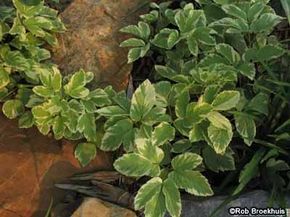Goutweed, also known as bishop's weed, is in England referred to as ground elder, and is as such the subject of many a frustrated English gardener. The botanical name means "little goat feet," and sometimes the plants have a tendency to run through the garden, out of control, using roots that ramble like little running feet.
Description of goutweed: Plants grow about 12 inches high with green leaves that are divided into three leaflets. The flowers are white, rangy, and not very attractive -- they should be cut off to prevent self-seeding.
Advertisement
How to grow goutweed: Goutweed adapts to just about any garden soil. Plants like partial shade, but they will grow in full sun if the soil is moist. If leaves turn brown from summer heat, they can be cut back and new fresh leaves will appear.
Propagating goutweed: By division in spring or fall.
Uses for goutweed: This plant makes a fine ground cover or planting for a slope that is too steep either for grass or for a regular garden. Since each piece of root will eventually lead to a new plant, care should be taken in planting. Goutweed should not be mixed in with other perennials. Plants should be grown where a solid edging will stop their spread, such as in a strip between a building and a sidewalk. They can also be used as a ground cover under trees and shrubs. Goutweed also does well in containers.
Goutweed related varieties: 'Variegata' is a plant with very attractive, light green leaves that are edged with white. It is much preferred over the solid green species.
Scientific name for goutweed: Aegopodium podagraria
Advertisement
